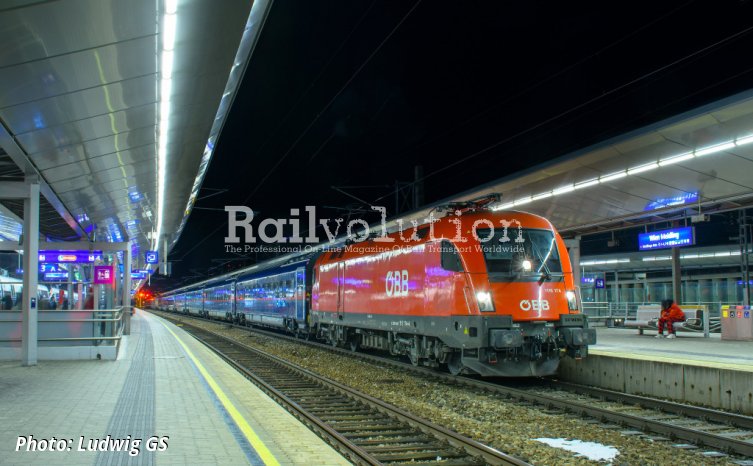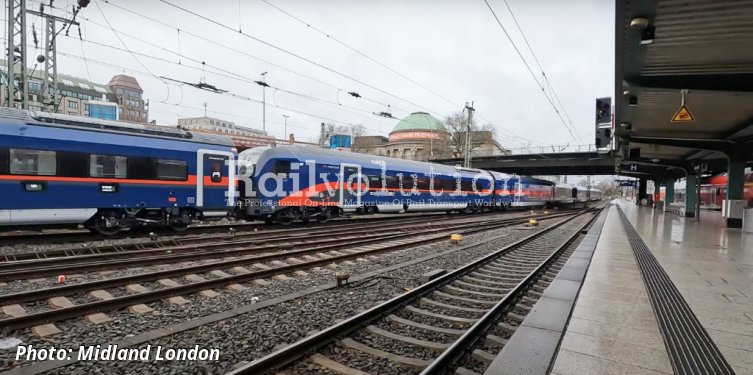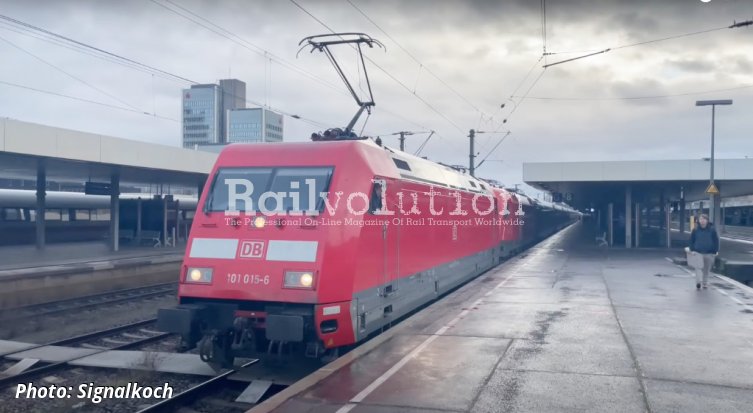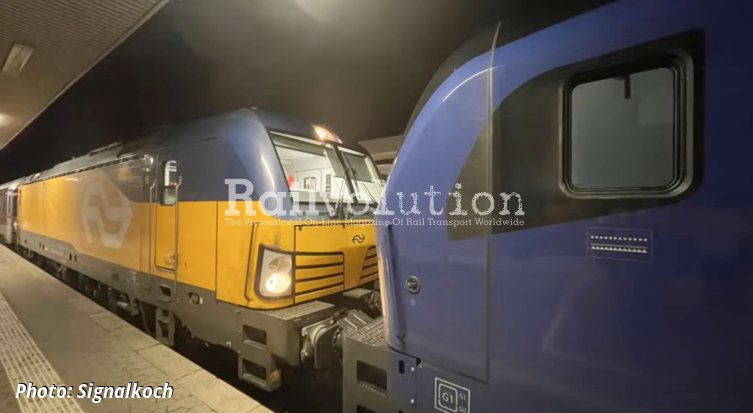Nightjet in operation and the approval details
posted on 22nd Jan 2024 16:50
On 10 December 2023, ÖBB started operating Viaggio non-traction multiple units (NMUs) on the NJ 40420/40491 Innsbruck - Hamburg and NJ 490/491 Wien - Hamburg services, which meet at Nürnberg Hbf and on which they replaced conventional locomotive-hauled rakes. Tauruses are used for these trains, as Vectrons have a maximum speed limit of 160 km/h in Austria and the ÖBB Class 1293 is not allowed for operation with passenger trains.
The photo 1 shows the first NJ 490/40420 service in the 2024 timetable on 11 December 2023 at Wien-Meidling (at 20.17 h), with 1116 174 in the front. Behind the nightjet NMU a group of old sleeper and couchette cars are coupled, destined for Amsterdam, this time together with a NS Vectron. In the 2023 timetable, these Vectrons (leased from ELL) hauled the NJ Amsterdam - Wien services on the entire route, so the locomotive in question was returning "home" from the last such NJ train in the just ended timetable).
The photo 2 shows the NJ 490/40420 service on 11 December 2023, here almost at its final destination - departing from Hamburg Hbf to Altona. The train consists of two NMUs - one for the Wien route (unit on the right) and one for the Innsbruck route (unit on the left). At the front of the train, i. e. on the far right behind the road bridge, was Taurus 1116 174, but due to a fault a Class 101 DB locomotive was coupled; the train in question was over three hours late on arrival, so the photo was taken at around noon instead of 08.47 h. The photo 3 shows NJ 490/40420 at Hannover with 101 015 and dead 1116 174.
Authorisation
The operation of nightjet NMUs is possible on account of the fact that on 24 November 2023 ERA „marked a significant milestone by formally authorising the first batch of new generation sleeper trains, which are being built by Siemens Mobility. These trains represent the first new design of sleeper trains in Europe, signalling a long-awaited departure from decades of stagnation in sleeper train development. The Vehicle Authorisation concerns 10 vehicle types representing 10 different coaches from Siemens Mobility. The authorisation granted allows operation in DACHI area (Germany, Austria, Switzerland, Italy) for day and night traffic, and the different vehicle types are each authorised as individual vehicles within predefined train formations."
A few details should be added to this earlier announcement by ERA and ÖBB. First of all, the ERA approval does not actually mention Switzerland (CH). This is due to the fact that this country is not in the EU, so the approval for Switzerland is handled individually through the BAV. However, as BAV told us, it has a cooperation agreement with the ERA (which was extended for another year in December 2023 as part of the transitional solution) so that it can conduct joint authorisation procedures with the European agency. As ERA approval does not apply to Switzerland for legal reasons, BAV subsequently issues a separate approval for this country; this happened on 5 December 2023 for the nightjet and railjet 2 non-traction units.
On 29 November 2023, Viaggio N, the Viaggio Next Level from Siemens Mobility, was registered in the ERATV (the European Register of Authorised Types of Vehicles). This entry covers ten car classes, namely Bbmpvz, Bcmz, Bfmpz, Bmpz, BRmpz, WLAmz1, WLAmz2, Ampz1, Ampz2 and ABbmpvz. The seven-car nightjet NMUs in their present form consist of only four classes:
- one Class Bfmpz driving trailer with seats,
- one Class ABbmpvz multi-purpose car with seats,
- three Class Bcmz couchettes,
- two Class WLAmz sleepers, where the WLAmz2 is an end car.
That means that the other six classes (Bfmpz, Bbmpvz, Bmpz, BRmpz, Ampz1, Ampz2) belong to the nine-car railjet 2 units, with the Class Bfmpz driving trailer being the same for both (day and night) Viaggio N train types and differing in inventory numbers - the nightjets have driving trailers designated 80-91 701 and above, and those of the railjets 2 have numbers 80-91 901 and above.
The ERA conditions of approval stipulate that Viaggio N rakes must consist of two end cars (it is understood that one of them can be a driving trailer), with 4 to 14 cars sandwiched between them. The intermediate cars can be arranged in any order, which means that it is theoretically possible to use nightjet cars in a railjet NMUs and vice versa; such a combination was encountered during the tests.
However, the fact that it is possible to combine nightjet and railjet cars is the result of their maximum unification, which can have various benefits over the lifetime of the vehicles, for example, if the driving trailer is damaged in an accident, these can be easily swapped between the railjet and the nightjet. Or if, after a period of operation, for example, it became apparent that there was a greater demand for seating in the nightjets, it would be possible to add a railjet car to the NMU, or swap it for another, without the need for additional approval.
The Viaggio N cars are not suitable for ferry services. It can be assumed that this is due to the length of the indivisible non-traction multiple unit, which may exceed the permitted length for the ferry; we have not been able to obtain further information on this. It is true that ferry services in Europe are nowadays less and less present. However, in some cases, the impossibility of ferrying trains may play a role - for example, Trenitalia, which, as part of the development of its night services, ordered separate new carriages, rather than non-traction multiple units in order to provide a direct connection from the mainland to Sicily.
The Viaggio N cars also cannot run on lines with a Crocodile type ATP, which is not a problem (yet) as this device is only found in France and Belgium. All Viaggio N cars are now, as part of approval phase 1, only homologated for pulled operation and no pushing mode is allowed. The Class Bfmpz car therefore only acts as an end car and its control systems and train protection systems are not active. For this reason, the ERA documentation states that this car does not have a driving cab. It is currently assumed that the Class Bfmpz will achieve authorisation for the driving car function in 2025 or 2026.
As a result, when turning in Hamburg from NJ 490/40420 to NJ 491/40491 service, the locomotive that previously ran from Wien and from Innsbruck must be coupled in front of the leading driving trailer in the direction of travel. Further handling then takes place at Nürnberg Hbf, where the groups to/from Hamburg (non-traction units) and Amsterdam (five classic cars) are rearranged. The photo 4 is from Nürnberg and shows the nightjet driving trailer 80-91 708 coupled to the Vectron of NS (on hire from ELL). The photo was taken on 11 December 2023, the NS Vectron was already there from Wien, running light. Normally the NS Vectron, capable of working on 1.5 kV DC, waits in Nürnberg to haul the car group to Amsterdam.
Speeds
Viaggio N cars are generally approved for 230 km/h. In Germany, however, the Class Bfmpz is only allowed to reach a maximum speed of 200 km/h, which logically limits the whole non-traction multiple unit, in which the other cars are approved for 230 km/h. As explained us by EBA, this is because for the approval process Siemens decided to set the maximum operating speed of the driving trailer at 200 km/h to comply with the notified national regulations. At this maximum speed it was possible to provide all the necessary evidence during the test runs to obtain approval for the Class Bfmpz driving trailer.
ÖBB told us that the current maximum speed of 200 km/h does not cause any delays in operation between Wien and Hamburg, since the travel times are designed for this speed also because of the fact that the old 200 km/h sleeper and couchette cars are also attached to each rake. A Viaggio N approval for 230 km/h in Germany is expected to be granted in mid-2025.
We asked ÖBB: does this mean that the classic sleeping cars will not be used on these trains from this moment on, so that the maximum speed 230 km/h of non-powered nightjet units can be achieved? Or will these NJ services still include old sleeping and couchette cars with the result that the trains will always run at a maximum speed of 200 km/h, even if there will be Viaggio N units authorised for 230 km/h? ÖBB answered: „If there are classic carriages on the train, the speed will remain at 200 km/h. This is sufficient for the timetable!“
In Italy and in Switzerland, the entire Viaggio N rake is limited to a maximum operating speed of 200 km/h, due to infrastructure. On this, BAV said that "SBB infrastructure is not designed for high-speed trains. There are no lines in Switzerland that allow speeds higher than 200 km/h." However, it should be added for the sake of accuracy that both the Gotthard and the Ceneri Base Tunnels are designed for a maximum speed of 250 km/h, although for normal operation, a maximum speed of 200 km/h is allowed to reduce energy consumption, and only in the case of delay reduction can trains run at 230 km/h.
Neither Siemens nor ÖBB have commented on what exactly is meant by the 200 km/h infrastructure limit in Italy, nor has the Italian authority ANSFISA, to whom we have also sent an enquiry. Anyway ÖBB told us only „No higher speed is planned in these countries“.
The ERA documentation further states that for operation in Italy on lines with speeds higher than 200 km/h, the operator shall be informed of the loads used to verify the car entrance doors during testing. The operator shall also be informed of the aerodynamic load limits for which the robustness of the Viaggio N entrance doors is confirmed for the safe operation of cars not designed for high speeds.
The nightjet NMU can only be hauled in Italy by Class E190 (1216 ÖBB) or E193 (Vectron) locomotives. The Class E193 may only be used provided that specific variants of these locomotives are already approved for passenger services with Viaggio N cars.
Deliveries - nightjet
At the start of the 2024 timetable, ÖBB had five nightjet NMUs. ÖBB is planning to convert the domestic NJ 446/447 Wien - Bregenz service to Viaggo N during the first half of 2024, for which two more NMUs and one as a reserve are needed. Until mid-January eight Viaggio N nightjet units have been produced.
TŽV Gredelj supports Siemens Mobility as a subcontractor for "technical modernization" of the nightjet NMUs built in Wien (see here). However, as ÖBB clarified, after the 35 cars (five units) no more work on the nightjets will take place there.
In total, ÖBB now has 33 seven-car Viaggio Next Level units on order for night services, to be delivered by 2025: a first 13-strong batch was ordered in August 2018, followed by a 20-strong option confirmed in August 2021.
Deliveries - railtjet
As for the railjet 2, it is expected that until April 2024 four units will be finished. This explain why have railjet 2 NMUs not already been put into service, although the aforementioned Viaggio N approval of ERA includes cars of the classes intended for railjet 2. The second of them, with driving trailer 80-91 902, was temporarilly stored at Ernstbrunn station, as there is no longer enough sidings in the Wien area, and the risk of vandalism in the Weinviertel region is much lower than in the capital. In the meantime, an unit with the driving trailer 80-91 901 appeared at the VUZ Velim test centre on 13 December 2023.
In total, ÖBB has initially eight nine-car railjet 2 units for daily services so far, which are envisaged for delivery by 2025. These units were acquired due to the new Italian fire protection guidelines (which came into force on 23 April 2023) and their primary task is to replace locomotive-hauled trains on the München - northern Italy route.
The latest news, which has not yet been presented to the public, is another contract for railjet 2 units. This has been reported on the auftrag.at ("contract.at") website. On 22 December 2023 ÖBB confirmed a further option under the framework contract of 1 August 2018 for the manufacture, authorisation and delivery of passenger cars for day and night services, thereby ordering a further 19 railjet 2 sets including various modifications and equipment options. The price amounts to 405.8 million EUR excluding VAT, and the contract is expected to be completed by 9 October 2028.
When asked whether the orderd is for nine- or seven-car units, ÖBB replied that this contract will be communicated in the coming weeks. Based on the contract value of 405.8 million EUR and the total number of 171 carriages for the nine-car variant, the average car price of 2.373 million EUR would suggest longer trainsets, just as it could be assumed that for daily long-distance trains ÖBB will prospectively buy nine-car rakes with more capacity than by seven-car ones.
Thus, of the framework contract for 700 Viaggio cars from August 2018 a total of 474 cars have been confirmed at this moment, as follows:
- 91 cars (thirteen seven-car nightjets),
- 140 cars (twenty seven-car nightjets),
- 72 cars (eight nine-car railjets),
- 171 cars (nineteen nine-car railjets).
They will form 60 units, which will be added to the existing fleet of 60 seven-car first-generation railjet NMUs, all of which require locomotives with a speed of 230 km/h. For further purchases of non-traction units from that framework contract, ÖBB now has 226 cars left.
230 km/h
The operation of nightjet NMUs shows that the speed of 230 km/h is not quite optimal: for high speed lines it is slow (which also applies to the Austrian Westbahn HSL, where the maximum line speed is "only" 250 km/h), while for lines with a top speed of 200 km/h, whether new or reconstructed, it is unnecessarily high and cannot be applied. And speeds over 230 km/h are not possible for the NMUs because the locomotives have a high axle weight for this purpose (compared to EMUs).
This is shown by the following paradoxes. For operations in Switzerland and Italy it is not possible to use or ÖBB does not plan to operate at speeds higher than 200 km/h. In Germany, where the approval of non-traction multiple Viaggio N units for 230 km/h is eventually foreseen and where, given the size of the country, the time savings from running at 230 km/h could be visible (albeit still in minutes), this possibility is on the contrary limited by the old 200 km/h sleeping and couchette cars that are and will be incorporated in the NJ services.
And Deutsche Bahn, which requires other operators (České dráhy) to run trains with a top speed of at least 230 km/h, now tolerates 200 km/h operation on these latest ÖBB trains. Albeit they are for night services, this does not change the fact that the track's speed parameters are not being used to the maximum.
Even in Austria, the new nightjets do not "enjoy" their top speed, as ÖBB have stated that "With the current timetable, it is not necessary to run NJ services at 230 km/h". This is actually a confirmation of the general fact that the top speed is not the most important factor for night trains. Passengers would appreciate much more if night trains ran exactly according to the timetable, rather than having to deal with delays of tens of minutes or even hundreds of minutes on a very regular basis...
However, a second phase of the approval process is now underway to achieve type approval in Germany for the Class Bfmpz driving trailers for 230 km/h, which could be applied at least to the railjet 2 units for daily services.
However, let's face it, these nuances are only of interest to rail experts, not passengers. The latter basically don't care at what speed, 200 or 230 km/h, the train is travelling through the countryside, because their main requirement is to reach their destination in comfort and on time. Let us therefore wish the ÖBB that its inovation of the nightjet fleet appeals to the maximum number of the public and that its (not only) night trains run according to schedule.




